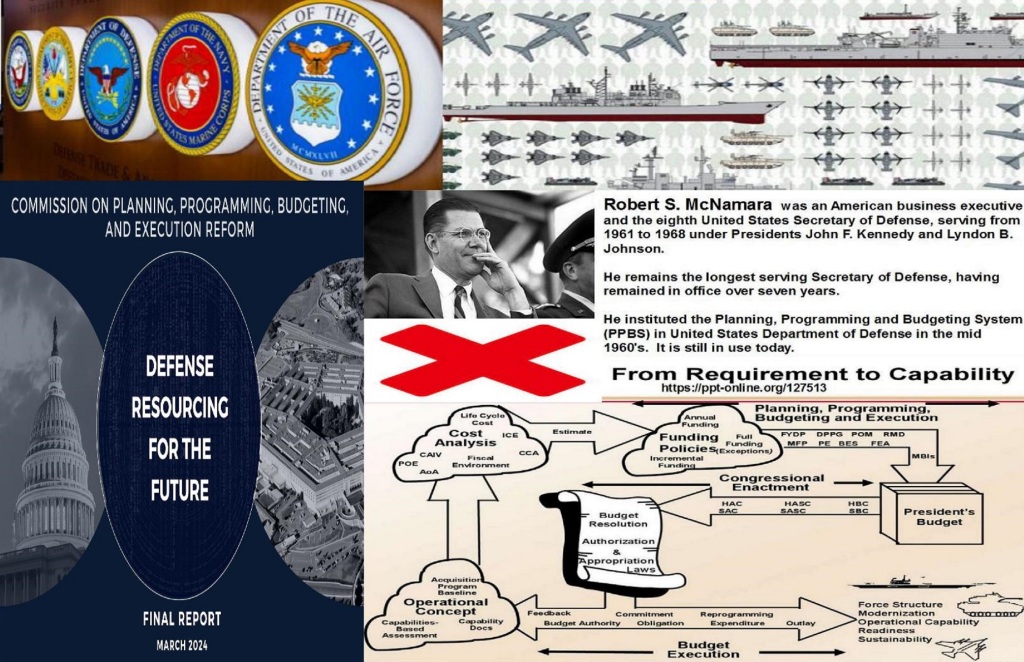
Click Image to Enlarge
“BREAKING DEFENSE By Valerie Insinna
“The commission calls for the wholesale replacement of the PPBE system with a new “defense resourcing system” that aims to align the budget request more closely to strategy.“
__________________________________________________________________________________________________________
“The almost 400-page report, published was written by the Commission on Planning, Programming, Budgeting and Execution (PPBE), draws on two years of research and more than 400 interviews, and resulted in 28 recommendations, half of which are denoted as key changes.
“The Pentagon requires a “fundamental restructuring” of its budget-making process and new authorities to make funding more flexible in order for the department to be able to quickly respond to new threats or adopt critically needed tech, according to a new report by congressionally mandated bipartisan commission.
Among them are reforms that would allow the Defense Department to address long-held complaints about the current budget process, including giving it new authorities to move money amongst weapons programs or to start new programs even while under a continuing resolution. That’s currently forbidden, and a CR, like the one the military is currently under, keeps spending exactly as it was the previous year.
While some of the recommendations can be immediately implemented by the Pentagon, others will need congressional approval or long-term buy-in from department leadership, said Ellen Lord, the commission’s vice chair and a former Pentagon acquisition chief.
“We believe we have a substantive document here with 28 very important recommendations that will all be for naught if we do not have implementation guidance from the department, as well as language from Congress,” she told reporters.
In a statement released this afternoon, Deputy Defense Secretary Kathleen Hicks commended the commission for their work but fell short of expressing support for any of the individual recommendations.
“The Department looks forward to evaluating the additional recommendations released by the PPBE Reform Commission today, in close cooperation with Congress, the Office of Management and Budget, and other stakeholders,” Hicks said.
Critics have slammed the current budget-making process for being slow and cumbersome, with the Pentagon beginning work on a budget about two years before funding is approved by Congress. That timeline can keep the Defense Department from being able to procure new tech like software and AI at the speed that they are made available in the commercial sector, the commission said.
“One of the most consistent concerns the commission heard over the past two years is that the current PPBE process lacks agility, limiting the department’s ability to respond quickly and effectively to evolving threats, unanticipated events and emerging technological opportunities,” the commission stated in the report.
At the same time, CRs and late budgets can also inhibit the department’s ability to start new programs or begin work on key initiatives.
The commission makes several other recommendations aimed at improving the flexibility of the budgeting process, such as raising the amount of funding that the Pentagon can shift among programs without needing congressional approval — known as below threshold reprogramming — and addressing “color of money” issues that can complicate buying software or make it difficult to replace the procurement of obsolescent parts with more widely available options.
One recommendation highly sought by some in the Pentagon would allow the department to carry over 5 percent of the budgets for operations and maintenance and military personnel into the following year, reducing the rush of spending that can occur by the military at the end of the year due to the current “use it or lose it” policy.
Another recommendation focuses on mitigating budgetary problems caused by a CR and would permit the Pentagon to begin a new start program or increase a production rate as laid out in a given budget request so long as the House and Senate appropriations committees had approved a bill including the new program or higher rate.
Robert Hale, the commission’s chairman and a former Pentagon comptroller, acknowledged that changes related to the carryover budget and CR could be a tough sell for Congressional appropriators, but added he believed the commission’s recommendations “balanced congressional oversight against some needed flexibility.”
The commission also calls for the creation of an analytic software platform that would crunch financial, contracting, logistics and readiness data “to allow decision makers to see the complete sight picture as never before, driving more meaningful decisions.”
The commission, which was created by Congress through fiscal 2022 National Defense Authorization Act, released an interim report in August that called for 13 immediate reforms.
Deputy Secretary of Defense Kathleen Hicks said then that the Pentagon would begin adopting “all actions that can be implemented now, as recommended by the Commission and within its purview.”
The department released its implementation plan for the first 13 recommendations laid out in the interim report.”
ABOUT THE AUTHOR:

Valerie Insinna
Valerie covers the congressional and defense industry beat for Breaking Defense. Valerie has extensive national security reporting expertise, having served as the air warfare beat reporter for Defense News for five years. During that time her work was recognized by numerous awards, including the prestigious National Press Club Michael A. Dornheim Award for defense journalism. Valerie most recently covered commercial aerospace for Reuters. She also previously worked at Defense Daily and National Defense Magazine.


